Bray Film Studios Proposals, Down Place, Windsor Building Design, Property Images
Bray Film Studios Windsor
Bray Film Studios Development design by a : b : i : r architects, England, UK
6 Jul 2012
Bray Film Studios Redevelopment
Redevelopment at Bray Film Studios Celebrates Rich History and Re-focuses Site for 21st Century
Location: Bray, Berkshire, south east England, UK – near Windsor
Design: a : b : i : r architects
The declining film studios at Bray – famous for its mid-20th century association with Hammer Films – is to be sensitively redeveloped under plans by a:b:i:r architects. The proposals focus on the refurbishment of Down Place the iconic, grade II listed Thames side manor house on the site which will be returned to a private residence with a new build contemporary media centre elsewhere on the site upgrading the production facilities for the 21st century.
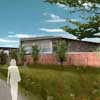
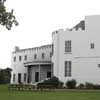
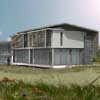
images : a : b : i : r architects
The proposals, which were unanimously approved subject to legal agreements by Royal Borough of Windsor & Maidenhead councillors last night also include the replacement of the large volume, unsightly, aging buildings and hardstanding with seven bespoke eco-houses set in extensively reintroduced landscaping.
The master planning of the 2.59Ha site which sits in an area of designated greenbelt on the side of the River Thames close to Windsor focuses on the sites rich history which as well as its association with Hammer Films also includes its role as one of the meeting places for the Kit-Kat club, a 39 man strong group with strong political and literary associations. Portraits of the 39 members still hang today in the National Gallery in London.
Key to the approval of the proposals was the return of Down Place to its original residential use. a:b:i:r architects’ early engagement with English Heritage informed much of the overall approach to the masterplan which allied this significant conservation project to a sensitive, contemporary approach elsewhere on the site.
Down Place was converted to offices and catering facilities during the studios heyday in the mid 20th Century with part of one wing housing a screening theatre complete with projection room (which is to be retained under the proposals). Currently this important and iconic house stands largely vacant with no other obvious future use following the decline of the studio business. The proposals have secured significant investment in the building which will now facilitate its refurbishment and secure its long-term future.
The new build residential and media office proposals will help enable the refurbishment of Down Place and result in the demolition and clearance of the existing large studio buildings to the benefit of the openness of the Green Belt and the historic setting and appearance of the Listed Buildings.
The media centre, sitting on the southern edge of the site detached from Down Place and the housing, allows the client to maintain his existing business at Bray, retaining an element of employment on site and maintaining the historic link with film, television and media.
Simon Atkins, director of a:b:i:r architects, said ‘We engaged with English Heritage and The Royal Borough of Windsor & Maidenhead to ensure we fully understood the context of the project. We presented to their Design Review panel who were very supportive of our contextual approach. This gave us the confidence to refine the scheme and we are delighted that the planning committee last night recognised that team effort. We believe these proposal sensitively address the issues of protecting a listed building, safeguarding a significant and contrasting history and improving the quality of the greenbelt”
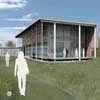
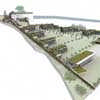
images : a : b : i : r architects
Bray : Masterplanning
The site is divided into three zones:
Zone 1- Down Place
The northern boundaries of Down Place are predefined and retained. The southern boundary is limited to the extent of the existing building which creates a secure private south facing garden.
Zone 2 – New Build Housing
Zone 2 establishes a considered route through the site based on historical pathways and provides secondary access to the rear of Down Place. The location and layout of the new buildings were tested against the existing massing and site constraints as well as consideration such as orientation and views.
Zone 3 – New Build Office & Media Building
The southernmost portion of the site is suited to employment use allowing vehicular movement to be contained and keeping any possibility of disturbance away from Down Place and the new dwellings. The area connects with the access road from Down Place ensuring that zone 3 is largely self-contained.
Bray Studios : Background & History
The main house at Bray Studios is an early eighteenth century mansion built on the side of a Roman town. The property and riverside grounds have always been known as Down Place and until 1949 it was a private residence.
An item of historical interest was its acquisition by a Bookseller of some notoriety named Jacob Tonson in 1720 who erected the impressive portico extension (which later formed part of internal stage facilities). He gathered around him the chief talent of his day to form the “Kit-Kat” club, consisting of 39 noblemen and gentlemen all distinguished for their rank, learning and wit. Many of them held important Government office and beneath the façade of literary joviality, the club had a more sinister objective, the defence of the House of Hanover. Sir Godfrey Kneller painted portraits of the members and these are currently hanging in the National Gallery in London.
In 1949 a new film company was formed called Hammer Films who acquired a lease at Down Place, with the freehold subsequently purchased several years later. Hammer is best known for its horror movies, the first of which was shot at Bray in 1956 – The Curse of Frankenstein – and the last in 1966 – The Mummies Shroud. A distribution deal with EMI in 1967 resulted in all future productions being transferred to the EMI studios at Boreham Wood. Apart from the horror films, many other notable films were produced such as the Hound of the Baskervilles, Phantom of the Opera, The Nanny, One Million Years BC.
Since that time, the studios have changed hands a number of times and were acquired by a property developer in late 1988. During the intervening period, Bray played host to many successful films such as the Music Lovers, Sunday Bloody Sunday, Pope Joan, For Queen & Country, Hope & Glory and the Witches. TV series over recent years include Terrahawks, Paradise Postponed, Inspector Morse, The Manageress, Forever Green and rehearsal space is regularly provided for the music industry including major groups, symphony orchestras and ballet companies.
The current owner and applicant, Bray Management Limited, acquired the site in 1990 and continued its use as a film, television and music recording studio. Changes in the industry, competition from other studios and the recent downturn in the economy means that it is unfortunately no longer a viable business.
Bray Film Studios – Building Information
Architect: a:b:i:r architects
Client: Bray Management Ltd
Planning Consultant: Pegasus Planning Group
Historic Building Consultant: CgMs Consulting Ltd
Sustainability: John Packer Associates
Traffic: PFA Consulting Ltd
Flood Risk: PFA Consulting Ltd
Archaeology: CgMs Consulting Ltd
Landscape: Pegasus Planning Group LLP
Structural Engineer: IE Consulting Engineers
Ecology: Aspect Ecology Ltd
Contamination: Bureau Veritas
Bray Film Studios images / information from a : b : i : r architects
Location: Bray, Windsor, Berkshire, England, UK
New English Architecture
Contemporary Architecture in England
English Architecture Designs – chronological list
English Architect – design firm listings
Key project by a : b : i : r architects
Brighton ‘Birdcage’ Bandstand
2009

image : Richard Rowland
Brighton Birdcage Bandstand
Berkshire Building – Recent Designs
Stryker Unveils Flagship Office
Capita Symonds
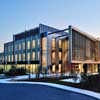
image from Capita Symonds
Berkshire Office Building
Virginia Water Pavilion, Windsor Great Park
Stanton Williams
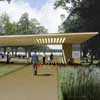
image from architects
Berkshire Building : latest design
Bradfield College Greek Theatre
studio octopi, Architects
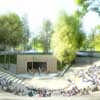
image from studio octopi
Bradfield College Greek Theatre
Hind House, Wargrave
John Pardey Architects

image from architect
Berkshire house
John Madejski Academy, Reading
Wilkinson Eyre Architects
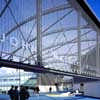
photograph : James Brittain
John Madejski Academy
Langley Academy, Slough
Foster + Partners
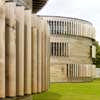
image : Foster + Partners
Langley Academy Slough
Berkshire Residential Buildings
Comments / photos for the Bray Film Studios page welcome
